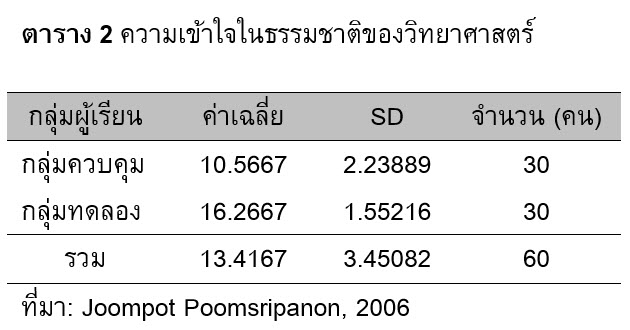การวิจัยในชั้นเรียน: เครื่องมือสำคัญของครูวิทยาศาสตร์
Main Article Content
Abstract
Joompot Poomsripanon
รับบทความ: 25 สิงหาคม 2555; ยอมรับตีพิมพ์: 18 ตุลาคม 2555
บทคัดย่อ
การวิจัยในชั้นเรียน (classroom action research) เป็นงานวิจัยที่แตกต่างจากการวิจัยตามรูปแบบ (formal research) เนื่องจากการวิจัยในชั้นเรียนเป็นการวิจัยที่มุ่งศึกษาเพื่อแก้ปัญหา หรือนำผลการวิจัยไปพัฒนากลุ่มเป้าหมายหรือสถานการณ์ที่จำเพาะเจาะจง การวิจัยจะลดกฎเกณฑ์และรูปแบบที่ซับซ้อนของงานวิจัยตามรูปแบบออกไป จึงทำให้ครูสามารถนำวิธีการวิจัยในชั้นเรียนไปพัฒนาการจัดกิจกรรมการเรียนการสอนได้สะดวก สำหรับครูวิทยาศาสตร์การวิจัยในชั้นเรียนเป็นเครื่องมือสำคัญอย่างหนึ่งที่ครูวิทยาศาสตร์จะนำไปใช้ในการพัฒนาการเรียนการสอนวิทยาศาสตร์ได้เป็นอย่างดี การที่ครูวิทยาศาสตร์จะใช้งานวิจัยในชั้นเรียนได้อย่างมีประสิทธิภาพ ต้องฝึกทักษะการตั้งคำถามงานวิจัยที่เหมาะสม วางแผนการเก็บข้อมูลอย่างเป็นระบบคู่ขนานไปกับการจัดกิจกรรมการเรียนการสอน และศึกษาหาความรู้เกี่ยวกับสถิติวิจัยเพื่อเป็นพื้นฐานในการวิเคราะห์ข้อมูลงานวิจัย
คำสำคัญ: การวิจัยในชั้นเรียน การวิจัยตามรูปแบบ ครูวิทยาศาสตร์ ทักษะการตั้งคำถาม สถิติวิจัย
Abstract
Classroom action research is different from formal research. Classroom action research aims to solve the problem or to develop a specific subject or situation. Classroom action research reduces the complexity of the rules and format of formal research. Thus, the teacher can easily use classroom action research to improve their classrooms in teaching and learning activities. For science teachers, classroom action research will be used as an important tool to improve science instruction as well. To use classroom action research more effectively in the classroom the science, teachers have to practice the questing skill for addressing problem or exposing the appropriate research questions. Science teachers have to plan to collect the data for their research together with teaching and learning activities. In addition, the basic research statistics is also necessary as a basis to analyze the data.
Keywords: Classroom action research, Formal research, Science teacher, Questing skill, Statistics
Downloads
Article Details

This work is licensed under a Creative Commons Attribution-NonCommercial 4.0 International License.
References
รัตนา ศรีเหรัญ. (2554). การวิจัยในชั้นเรียนสู่เส้นทางวิชาชีพครู. สำนักงาน ก.ค. กระทรวงศึกษาธิการ.
วัลลภา เทพหัสดิน ณ อยุธยา. (2544). การพัฒนาการเรียนการสอนทางอุดมศึกษา. กรุงเทพฯ: จุฬาลงกรณ์มหาวิทยาลัย.
ศิริชัย กาญจนวาสี. (2532). มิติใหม่ของการวิจัยทางการ ศึกษา. วารสารวิธีวิทยาการวิจัย 4(1): 1 – 8.
สรชัย พิศาลบุตร. (2547). การวิจัยในชั้นเรียน. กรุงเทพฯ: วิทยพัฒน์.
สุวิมล ว่องวาณิช. (2544). การวิจัยปฏิบัติการในชั้นเรียน. กรุงเทพฯ: อักษรไทย.
Campoy, Renee. (2005). Learning and Teaching Research – based Methods. Boston: Pearson Education.
Joompot Poomsripanon.(2006). The enhancement of an understanding the nature of science by the use of GIS for study the mollusk ecology through 5Es learning cycle model. Doctor of Philosophy, Graduate School, Mahidol University, Thailand.
Lehmann and Mehrens. (1979). Educational Research. Holt, Rinehart, and Winston, California.
Merter, C. (2006). Action research: Teachers as re-searchers in the classroom. London: Sage.
Sardo–Brown, D., Welsh, L. A., and Bolton, D. L. (1995). Practical Strategies for Facilitating Classroom Teachers’ Involvement in Action Research. Ed-ucation (Chula Vista, Calif.) 115: 553– 559.
